Prevalence of Possible Sleep Bruxism and Its Association with Social and Orofacial Factors in Preschool Population
Abstract
1. Introduction
2. Materials and Methods
2.1. Geographical Area, Sample Size and Selection Criteria
2.2. Questionary
2.3. Clinical Exam
2.4. Statistical Analysis
3. Results
3.1. Sample Description
3.2. Social Class
3.3. Parafunctional Habits
3.4. Occlusal Characteristics
4. Discussion
4.1. Bruxism Prevalence
4.2. Association with Sex
4.3. Association with Social Factors
4.4. Association with Orofacial Factors and Habits
4.5. Association with Occlusal Characteristics
4.6. Association with Diastemas and Dental Crowding
4.7. Strengths and Limitations
5. Conclusions
Author Contributions
Funding
Institutional Review Board Statement
Informed Consent Statement
Data Availability Statement
Acknowledgments
Conflicts of Interest
References
- Bulanda, S.; Ilczuk-Rypuła, D.; Nitecka-Buchta, A.; Nowak, Z.; Baron, S.; Postek-Stefańska, L. Sleep bruxism in children: Etiology, diagnosis and treatment—A literature review. Int. J. Environ. Res. Public Health 2021, 18, 9544. [Google Scholar] [CrossRef] [PubMed]
- Peres, K.G.; Cascaes, A.M.; Nascimento, G.G.; Victoria, C.G. Effect of breastfeeding on malocclusions: A systematic review and meta-analysis. Acta Paediatr. 2015, 104, 54–61. [Google Scholar] [CrossRef] [PubMed]
- Casazza, E.; Giraudeau, A.; Payet, A.; Orthlieb, J.D.; Camoin, A. Management of idiopathic sleep bruxism in children and adolescents: A systematic review of the literature. Arch. Pediatr. 2022, 29, 12–20. [Google Scholar] [CrossRef]
- Chisini, L.A.; Schmidt, A.; Martin, S.; Cademartori, M.G.; Boscato, N.; Correa, M.B.; Goettems, M.L. Interventions to reduce bruxism in children and adolescents: A systematic scoping review and critical reflection. Eur. J. Pediatr. 2020, 179, 177–189. [Google Scholar] [CrossRef] [PubMed]
- Calvano Küchler, E.; Arid, J.; Palinkas, M.; Ayumi Omori, M.; de Lara, R.M.; Napolitano Gonçalves, L.M.; Hallak Regalo, S.C.; Paes Torres Mantovani, c.; Rezende Vieira, A.; Diaz-Serrano, K. Genetic polymorphisms in ACTN3 contribute to the etiology of bruxism in children. J. Clin. Pediatr. Dent. 2020, 44, 180–184. [Google Scholar] [CrossRef] [PubMed]
- Baad-Hansen, L.; Thymi, M.; Lobbezoo, F.; Svensson, P. To what extent is bruxism associated with musculoskeletal signs and symptoms? A systematic review. J. Oral Rehabil. 2019, 46, 845–861. [Google Scholar]
- Oliveira Reis, L.; Ribeiro, R.A.; Martins, C.C.; Devito, K.L. Association between bruxism and temporomandibular disorders in children: A systematic review and meta-analysis. Int. J. Paediatr. Dent. 2019, 29, 585–595. [Google Scholar] [CrossRef]
- Magalhães, B.G.; Freitas, J.L.M.; Barbosa, A.C.D.S.; Gueiros, M.C.S.N.; Gomes, S.G.F.; Rosenblatt, A.; Caldas Junior, A.F. Temporomandibular disorder: Otologic implications and its relationship to sleep bruxism. Braz. J. Otorhinolaryngol. 2018, 84, 614–619. [Google Scholar] [CrossRef]
- Soares, J.P.; Giacomin, A.; Cardoso, M.; Serra-Negra, J.M.; Bolan, M. Association of gender, oral habits, and poor sleep quality with possible sleep bruxism in schoolchildren. Braz. Oral Res. 2020, 34, e019. [Google Scholar] [CrossRef]
- Soares, J.P.; Moro, J.; Massignan, C.; Cardoso, M.; Serra-Negra, J.M.; Maia, L.C.; Bolan, M. Prevalence of clinical signs and symptoms of the masticatory system and their associations in children with sleep bruxism: A systematic review and meta-analysis. Sleep Med. Rev. 2021, 57, 101468. [Google Scholar] [CrossRef]
- Vieira, K.R.M.; Folchini, C.M.; Heyde, M.D.V.D.; Stuginski-Barbosa, J.; Kowacs, P.A.; Piovesan, E.J. Wake-Up Headache Is Associated With Sleep Bruxism. Headache 2020, 60, 974–980. [Google Scholar] [CrossRef] [PubMed]
- Nahás-Socate, A.C.R.; Coelho, F.V.; de Almeida, V.C. Bruxism in children and transverse plane of occlusion: Is there a relationship or not? Dental. Press J. Orthod. 2014, 19, 67–73. [Google Scholar] [CrossRef] [PubMed]
- Alencar, N.A.; Fernandes, A.B.; Souza, M.M.; Luiz, R.R.; Fonseca-Gonçalves, A.; Maia, L.C. Lifestyle and oral facial disorders associated with sleep bruxism in children. Cranio 2017, 35, 168–174. [Google Scholar] [CrossRef]
- Castroflorio, T.; Bargellini, A.; Rossini, G.; Cugliari, G.; Deregibus, A. Sleep bruxism in adolescents: A systematic literature review of related risk factors. Eur. J. Orthod. 2017, 39, 61–68. [Google Scholar] [CrossRef] [PubMed]
- Castroflorio, T.; Bargellini, A.; Rossini, G.; Cugliari, G.; Rainoldi, A.; Deregibus, A. Risk factors related to sleep bruxism in children: A systematic literature review. Arch. Oral Biol. 2015, 60, 1618–1624. [Google Scholar] [CrossRef]
- Palinkas, M.; Semprini, M.; Filho, J.E.; de Luca Canto, G.; Regalo, I.H.; Bataglion, C.; Rodrigues, L.A.M.; Siéssere, S.; Regalo, S.C.H. Nocturnal sleep architecture is altered by sleep bruxism. Arch. Oral Biol. 2017, 81, 56–60. [Google Scholar] [CrossRef]
- Restrepo, C.; Manfredini, D.; Lobbezoo, F. Sleep behaviors in children with different frequencies of parental-reported sleep bruxism. J. Dent. 2017, 66, 83–90. [Google Scholar] [CrossRef]
- Ribeiro-Lages, M.B.; Jural, L.A.; Magno, M.B.; Vicente-Gomila, J.; Ferreira, D.M.; Fonseca-Gonçalves, A.; Maia, L.C. A world panorama of bruxism in children and adolescents with emphasis on associated sleep features: A bibliometric analysis. J. Oral Rehabil. 2021, 48, 1271–1282. [Google Scholar] [CrossRef]
- Simões-Zenari, M.; Bitar, M.L. Factors associated to bruxism in children from 4–6 years. Pró-Fono Rev. Atualização Científica 2010, 22, 465–472. [Google Scholar] [CrossRef]
- Brancher, L.C.; Cademartori, M.G.; Jansen, K.; da Silva, R.A.; Bach, S.; Reyes, A.; Boscato, N.G.M. Social, emotional, and behavioral problems and parent-reported sleep bruxism in schoolchildren. J. Am. Dent. Assoc. 2020, 151, 327–333. [Google Scholar] [CrossRef]
- Alfano, C.A.; Bower, J.L.; Meers, J.M. Polysomnography-detected bruxism in children is associated with somatic complaints but not anxiety. J. Clin. Sleep Med. 2018, 14, 23–29. [Google Scholar] [CrossRef] [PubMed]
- Alves, C.L.; Fagundes, D.M.; Ferreira Soares, P.B.; Ferreira, M.C. Knowledge of parents/caregivers about bruxism in children treated at the pediatric dentistry clinic. Sleep Sci. 2019, 12, 185–189. [Google Scholar] [CrossRef] [PubMed]
- Lobbezoo, F.; Ahlberg, J.; Glaros, A.G.; Kato, T.; Koyano, K.; Lavigne, J.G.; de Leeuw, R.; Manfredini, D.; Svennsson, P.; Winocur, E. Bruxism defined and graded: An international consensus. J. Oral Rehabil. 2013, 40, 2–4. [Google Scholar] [CrossRef]
- Pérez, D.M.; Benlloch, R.I.; Nazareth, R.P.; Rosa, M.M.M. Case Report: Tratment of childhood Bruxism trough the rehabilitation Neuro-Occlusal. OAJODS 2017, 2, 000128. [Google Scholar]
- Domingo-Salvany, A.; Regidor, E.; Alonso, J.; Álvarez-Dardet, C. Una propuesta de medida de la clase social. Gerupo de trabajo de la Sociedad Española de Epidemiología y de la Sociedad Española de Medicina de Familia y Comunitaria. Aten. Primaria 2000, 25, 350–363. [Google Scholar]
- World Health Organization. Available online: http://link.springer.com/10.1007/978-3-642-15352-5_3 (accessed on 12 May 2020).
- Sriram, C.H.; Priya, V.K.; Sivakumar, N.; Reddy, K.R.; Babu, P.J.; Reddy, P. Occlusion of primary dentition in preschool children of Chennai and Hyderabad: A comparative study. Contemp. Clin. Dent. 2012, 3, 31–37. [Google Scholar] [CrossRef]
- Clementino, M.A.; Siqueira, M.B.; Serra-Negra, J.M.; Paiva, S.M.; Granville-Garcia, A.F. The prevalence of sleep bruxism and associated factors in children: A report by parents. Eur. Arch. Paediatr. Dent. 2017, 18, 399–404. [Google Scholar] [CrossRef]
- Ghafournia, M.; Hajenourozali Tehrani, M. Relationship between Bruxism and Malocclusion among Preschool Children in Isfahan. J. Dent. Res. Dent. Clin. Dent. Prospect. 2012, 6, 138–142. [Google Scholar]
- Massignan, C.; de Alencar, N.A.; Soares, J.P.; Santana, C.M.; Serra-Negra, J.; Bolan, M.; Cardoso, M. Poor sleep quality and prevalence of probable sleep bruxism in primary and mixed dentitions: A cross-sectional study. Sleep Breath 2019, 23, 935–941. [Google Scholar] [CrossRef]
- Gomes, M.C.; Neves, É.T.; Perazzo, M.F.; de Souza, E.G.C.; Serra-Negra, J.M.; Paiva, S.M.; Granville-García, A.F. Evaluation of the association of bruxism, psychosocial and sociodemographic factors in preschoolers. Braz. Oral Res. 2018, 32, e009. [Google Scholar] [CrossRef]
- Insana, S.P.; Gozal, D.; McNeil, D.W.; Montgomery-Downs, H.E. Community based study of sleep bruxism during early childhood. Sleep Med. 2013, 14, 183–188. [Google Scholar] [CrossRef] [PubMed]
- Ramos, P.F.C.; de Lima, M.D.M.; de Moura, M.S.; Bendo, C.B.; Moura, L.F.A.D.; Lima, C.C.B. Breathing problems, being an only child and having parents with possible sleep bruxism are associated with probable sleep bruxism in preschoolers: A population-based study. Sleep Breath 2021, 25, 1677–1684. [Google Scholar] [CrossRef] [PubMed]
- Da Costa, S.V.; de Souza, B.K.; Cruvinel, T.; Oliveira, T.M.; Lourenço Neto, N.; Machado, M.A.A.M. Factors associated with preschool children’s sleep bruxism. Cranio 2021, 25, 1–7. [Google Scholar] [CrossRef] [PubMed]
- De Alencar, N.A.; Leão, C.S.; Leão, A.T.T.; Luiz, R.R.; Fonseca-Gonçalves, A.; Maia, L.C. Sleep bruxism and anxiety impacts in quality of life related to oral health of Brazilian children and their families. J. Clin. Pediatr. Dent. 2017, 41, 179–185. [Google Scholar] [CrossRef] [PubMed]
- Ferrari-Piloni, C.; Barros, L.A.N.; Evangelista, K.; Serra-Negra, J.M.; Silva, M.A.G.; Valladares-Neto, J. Prevalence of Bruxism in Brazilian Children: A Systematic Review and Meta-Analysis. Pediatr. Dent. 2022, 44, 8–20. [Google Scholar] [PubMed]
- Manfredini, D.; Lobbezoo, F.; Giancristofaro, R.A.; Restrepo, C. Association between proxy-reported sleep bruxism and quality of life aspects in Colombian children of different social layers. Clin. Oral Investig. 2017, 21, 1351–1358. [Google Scholar] [CrossRef]
- Drumond, C.L.; Paiva, S.M.; Vieira-Andrade, R.G.; Ramos-Jorge, J.; Ramos-Jorge, M.L.; Provini, F.; Serra-Negra, J.M.C. Do family functioning and mothers’ and children’s stress increase the odds of probable sleep bruxism among schoolchildren? A case control study. Clin. Oral Investig. 2020, 24, 1025–1033. [Google Scholar] [CrossRef]
- Lamenha Lins, R.M.; Cavalcanti Campêlo, M.C.; Figueiredo, L.M.; Heimer, M.V.; dos Santos-Junior, V.E. Probable sleep bruxism in children and its relationship with harmful oral habits, type of crossbite and oral breathing. J. Clin. Pediatr. Dent. 2020, 44, 66–69. [Google Scholar] [CrossRef]
- Hazar Bodrumlu, E.; Çakmak Özlü, F.; Yılmaz, H.; Demiriz, L. Investigating the effect of bruxism on maxillary arch length and width in children using three-dimensional digital model analysis. Prog. Orthod. 2022, 23, 2. [Google Scholar] [CrossRef]
- Ribeiro-Lages, M.B.; Martins, M.L.; Magno, M.B.; Masterson Ferreira, D.; Tavares-Silva, C.M.; Fonseca-Gonçalves, A.; Serra-Negra, J.M.; Maia, L.C. Is there association between dental malocclusion and bruxism? A systematic review and meta-analysis. J Oral Rehabil 2020, 47, 1304–1318. [Google Scholar] [CrossRef]
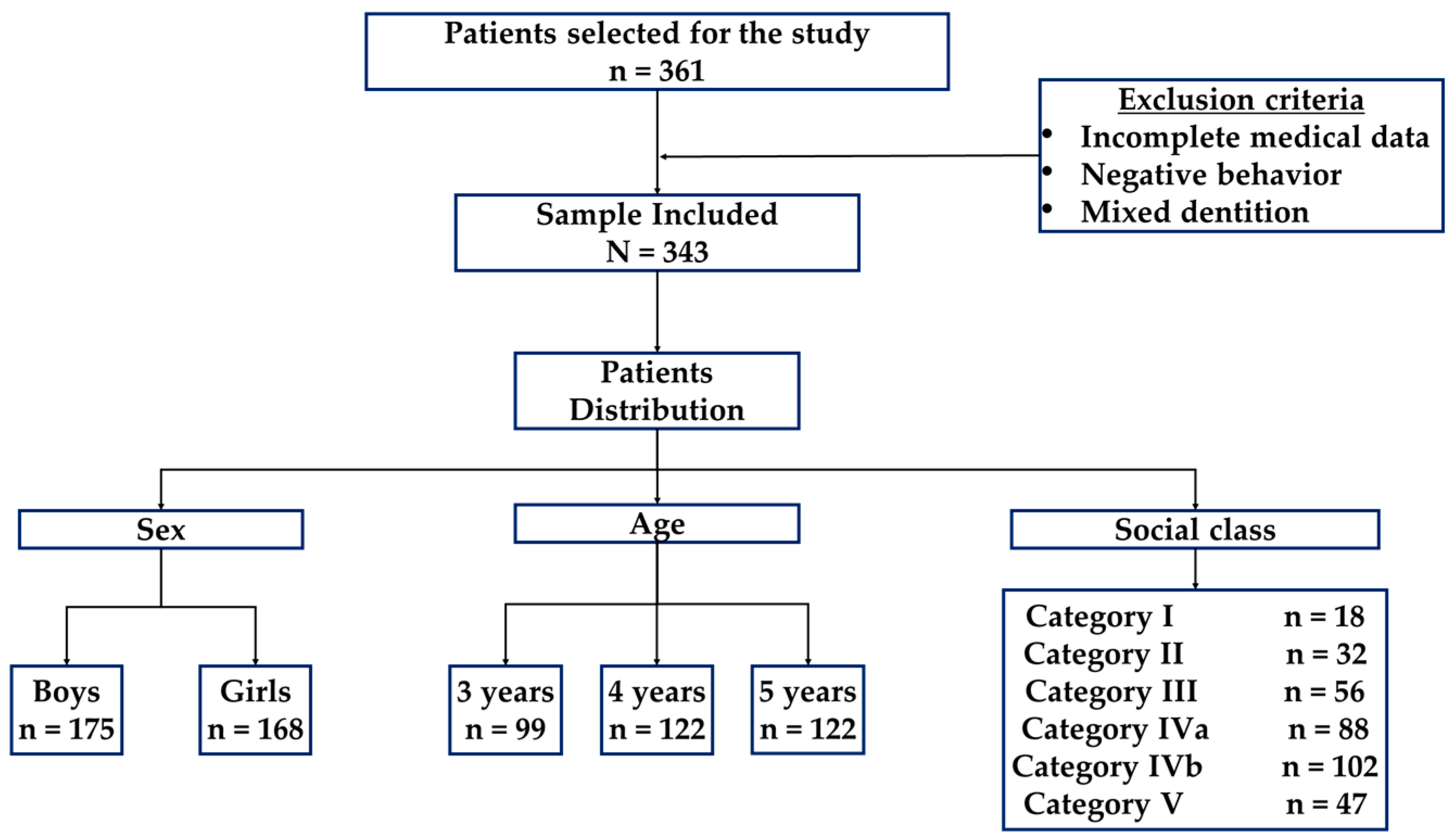
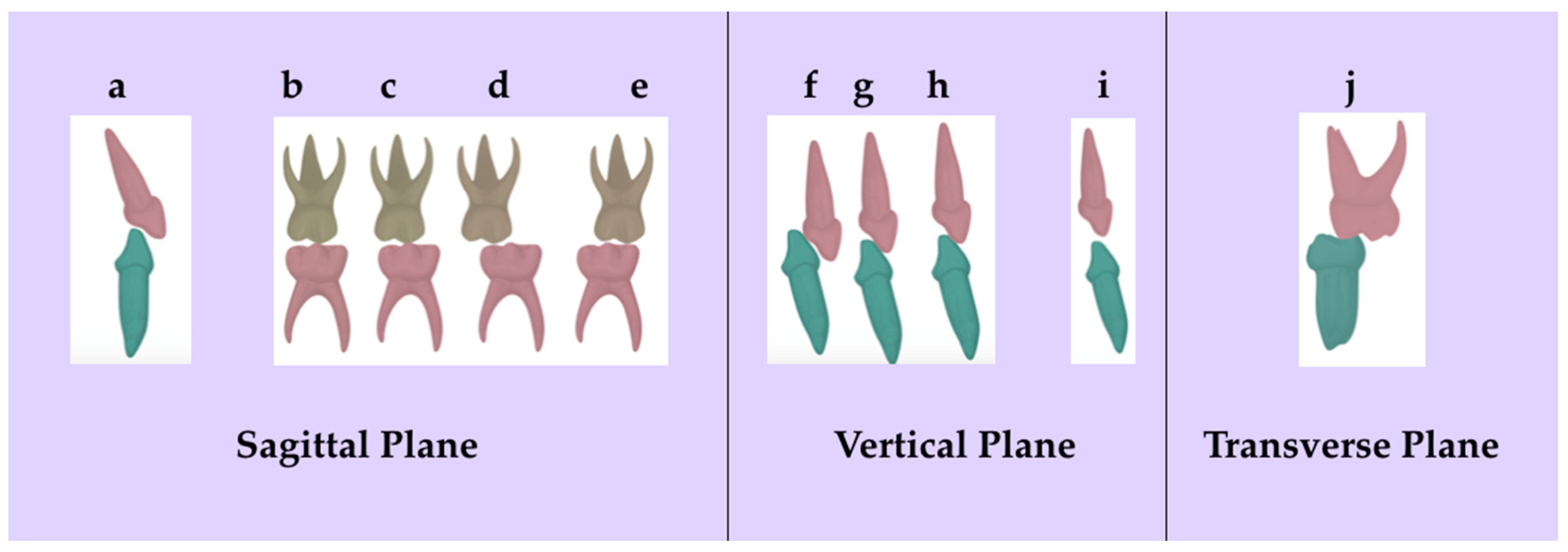
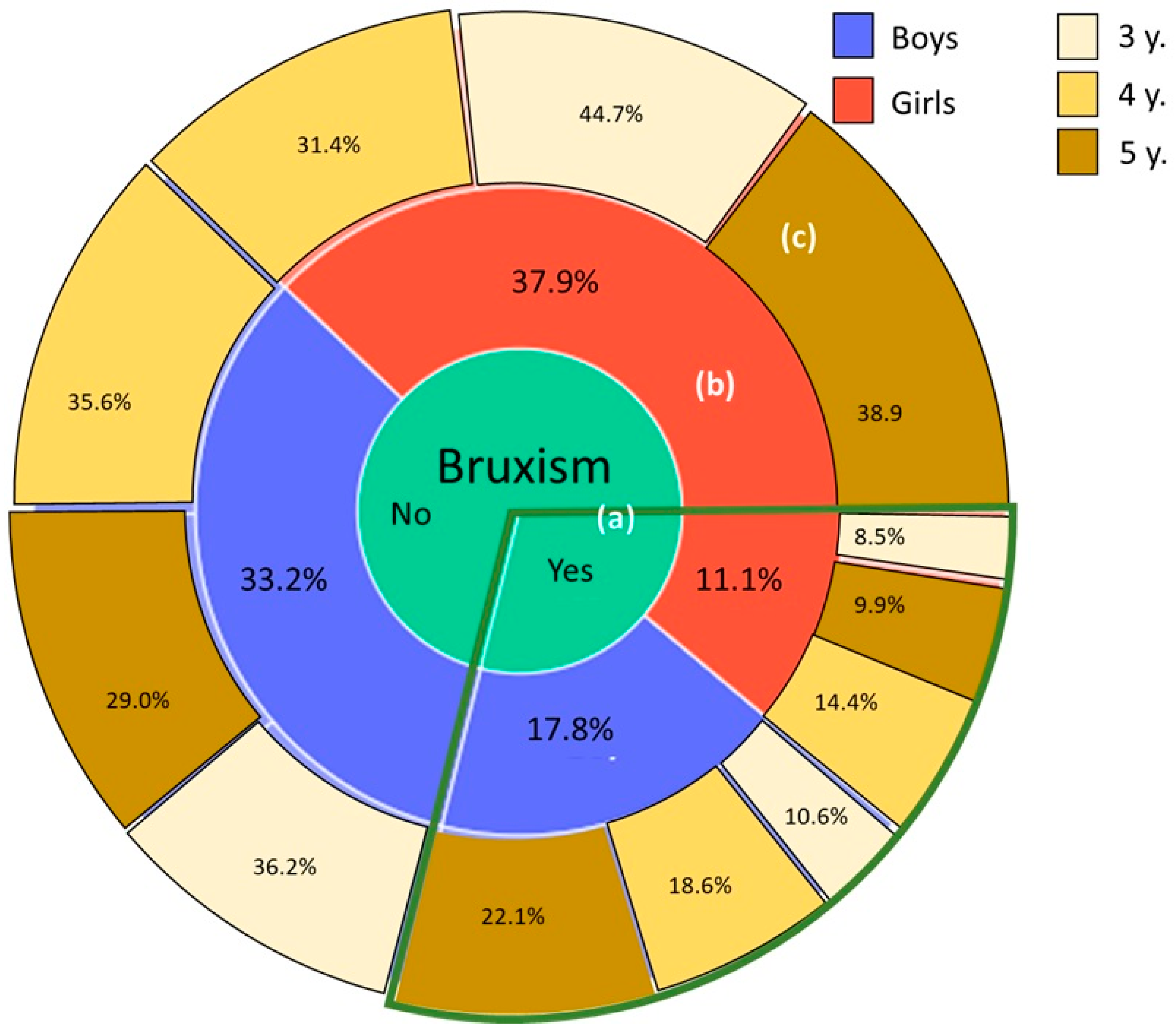
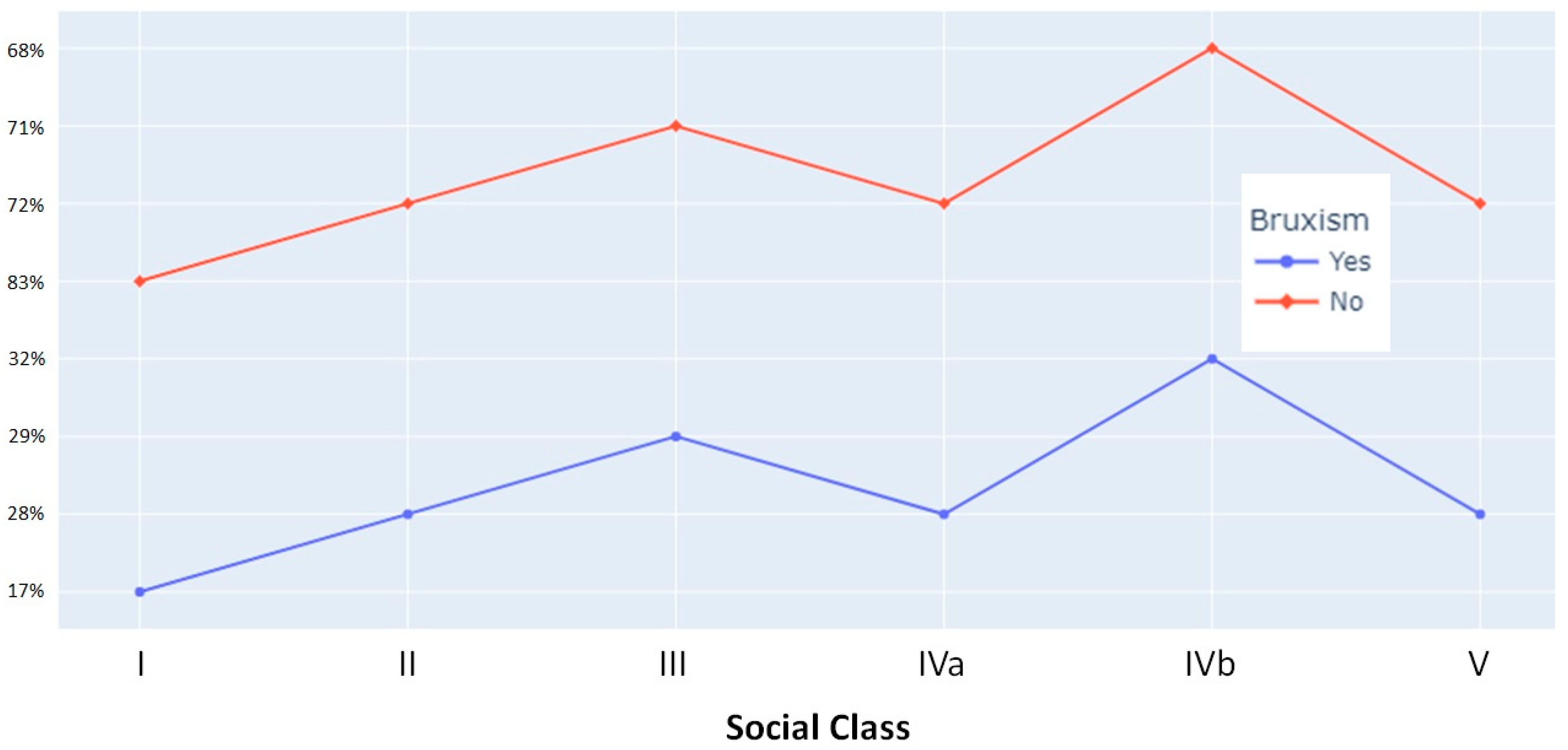
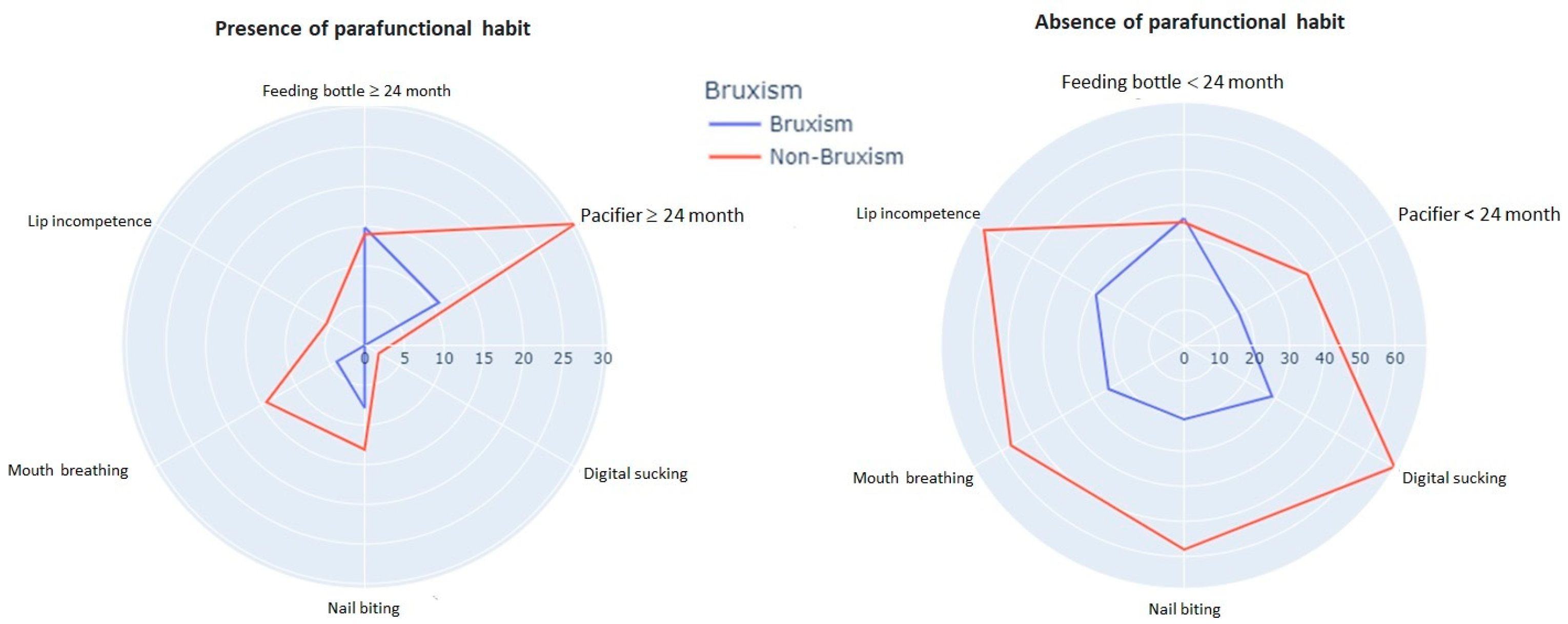
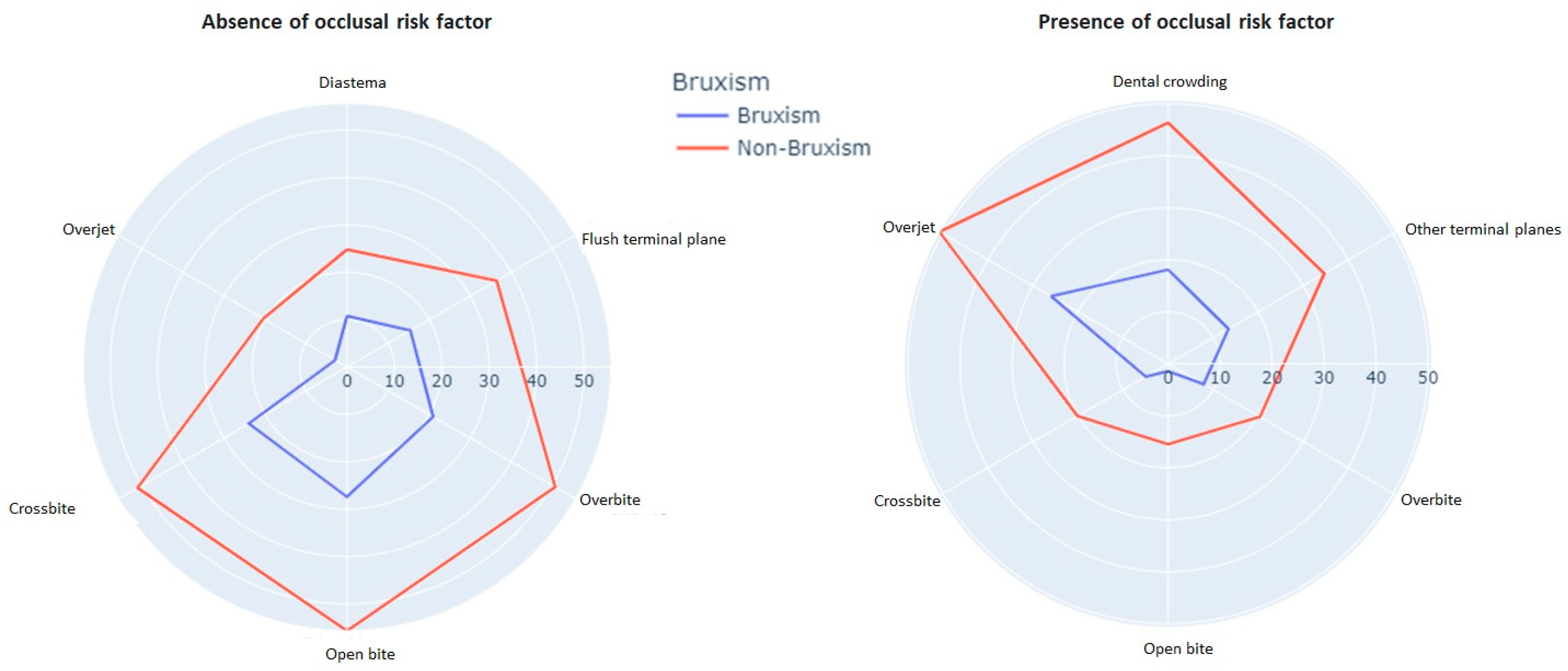
| Social Class | |
|---|---|
| I | Directors of Public Administration and companies with ten or more employees Professions associated with second and third-cycle university degrees |
| II | Company managers with less than ten employees Professions associated with a first-cycle university degree. Technicians, artists, and athletes |
| III | Administrative employees and support professionals for administrative and financial management Workers of personal and security services Free-lancers Manual worker supervisors |
| IVa | Skilled manual workers |
| IVb | Semi-skilled manual workers |
| V | Unskilled workers |
| Social Class | Bruxism (Yes) n (%) | Bruxism (No) n (%) | p |
|---|---|---|---|
| I | 3 (3.1) | 15 (6.1) | 0.854 |
| II | 9 (9.1) | 23 (9.4) | |
| III | 16 (16.2) | 40 (16.4) | |
| IVa | 25 (25.3) | 63 (25.8) | |
| IVb | 33 (33.3) | 69 (28.3) | |
| V | 13 (13.1) | 34 (13.9) | |
| Total | 99 (100) | 244 (100) |
| Parafunctional Habits | Bruxism (Yes) n (%) | Bruxism (No) n (%) | PR | CI 95% | p |
|---|---|---|---|---|---|
| Pacifier | |||||
| ≥24 months | 37 (37.4) | 105 (43.0) | 1.27 | 0.78–2.04 | 0.132 |
| <24 months | 62 (62.6) | 139 (57.0) | |||
| Feeding Bottle | |||||
| ≥24 months | 51 (51.5) | 48 (48.5) | 1.03 | 0.64–1.64 | 0.907 |
| <24 months | 124 (50.8) | 120 (49.2) | |||
| Digital Sucking | |||||
| Presence | 0 (0.0) | 7 (2.9) | 0.199 | ||
| Absence | 99 (100) | 237 (97.1) | |||
| Nail Biting | |||||
| Presence | 27 (27.3) | 45 (18.4) | 1.66 | 0.96–2.87 | 0.069 |
| Absence | 72 (72.7) | 199 (81.6) | |||
| Mouth Breathing | |||||
| Presence | 14 (14.1) | 49 (20.1) | 0.66 | 0.34–1.25 | 0.198 |
| Absence | 85 (85.9) | 195 (79.9) | |||
| Lip Incompetence | |||||
| Presence | 0 (0.0) | 9 (7.8) | 0.003 | ||
| Absence | 99 (100) | 225 (92.2) | |||
| Occlusal Characteristics | Bruxism (Yes) n (%) | Bruxism (No) n (%) | PR | CI 95% | p |
|---|---|---|---|---|---|
| Diastemas | |||||
| Dental crowding | 62 (62.6) | 159 (62.5) | 0.9 | 0.55–1.45 | 0.656 |
| Diastemas | 37 (37.4) | 85 (34.8) | |||
| Relationship of the primary molars | |||||
| Short mesial step | 11 (11.1) | 41 (16.8) | 0.91 | 0.57–1.46 | 0.699 |
| Long mesial step | 3 (3.0) | 10 (4.1) | |||
| Distal step | 18 (18.2) | 34 (13.9) | |||
| Mixed component | 14 (14.1) | 34 (13.9) | |||
| Flush terminal plane | 53 (53.5) | 125 (51.2) | |||
| Overjet | |||||
| Presence | 27 (27.3) | 70 (28.7) | 0.93 | 0.55–1.57 | 0.792 |
| Absence | 72 (72.7) | 174 (71.3) | |||
| Open bite | |||||
| Presence | 5 (5.1) | 53 (21.7) | 0.19 | 0.07–0.50 | 0.000 |
| Absence | 94 (94.9) | 191 (78.3) | |||
| Crossbite | |||||
| Presence | 17 (17.2) | 69 (28.3) | 0.53 | 0.29–0.95 | 0.032 |
| Absence | 82 (82.9) | 175 (71.7) | |||
| Overbite | |||||
| 1/3 | 26 (26.3) | 59 (24.2) | 3.58 | 1.76–7.28 | 0.002 |
| 2/3 | 34 (34.3) | 57 (23.4) | |||
| 3/3 | 29 (29.3) | 58 (23.8) | |||
| No | 10 (10.1) | 70 (28.7) | |||
Disclaimer/Publisher’s Note: The statements, opinions and data contained in all publications are solely those of the individual author(s) and contributor(s) and not of MDPI and/or the editor(s). MDPI and/or the editor(s) disclaim responsibility for any injury to people or property resulting from any ideas, methods, instructions or products referred to in the content. |
© 2023 by the authors. Licensee MDPI, Basel, Switzerland. This article is an open access article distributed under the terms and conditions of the Creative Commons Attribution (CC BY) license (https://creativecommons.org/licenses/by/4.0/).
Share and Cite
Diéguez-Pérez, M.; Ticona-Flores, J.M.; Prieto-Regueiro, B. Prevalence of Possible Sleep Bruxism and Its Association with Social and Orofacial Factors in Preschool Population. Healthcare 2023, 11, 1450. https://doi.org/10.3390/healthcare11101450
Diéguez-Pérez M, Ticona-Flores JM, Prieto-Regueiro B. Prevalence of Possible Sleep Bruxism and Its Association with Social and Orofacial Factors in Preschool Population. Healthcare. 2023; 11(10):1450. https://doi.org/10.3390/healthcare11101450
Chicago/Turabian StyleDiéguez-Pérez, Montserrat, Jesús Miguel Ticona-Flores, and Beatriz Prieto-Regueiro. 2023. "Prevalence of Possible Sleep Bruxism and Its Association with Social and Orofacial Factors in Preschool Population" Healthcare 11, no. 10: 1450. https://doi.org/10.3390/healthcare11101450
APA StyleDiéguez-Pérez, M., Ticona-Flores, J. M., & Prieto-Regueiro, B. (2023). Prevalence of Possible Sleep Bruxism and Its Association with Social and Orofacial Factors in Preschool Population. Healthcare, 11(10), 1450. https://doi.org/10.3390/healthcare11101450






